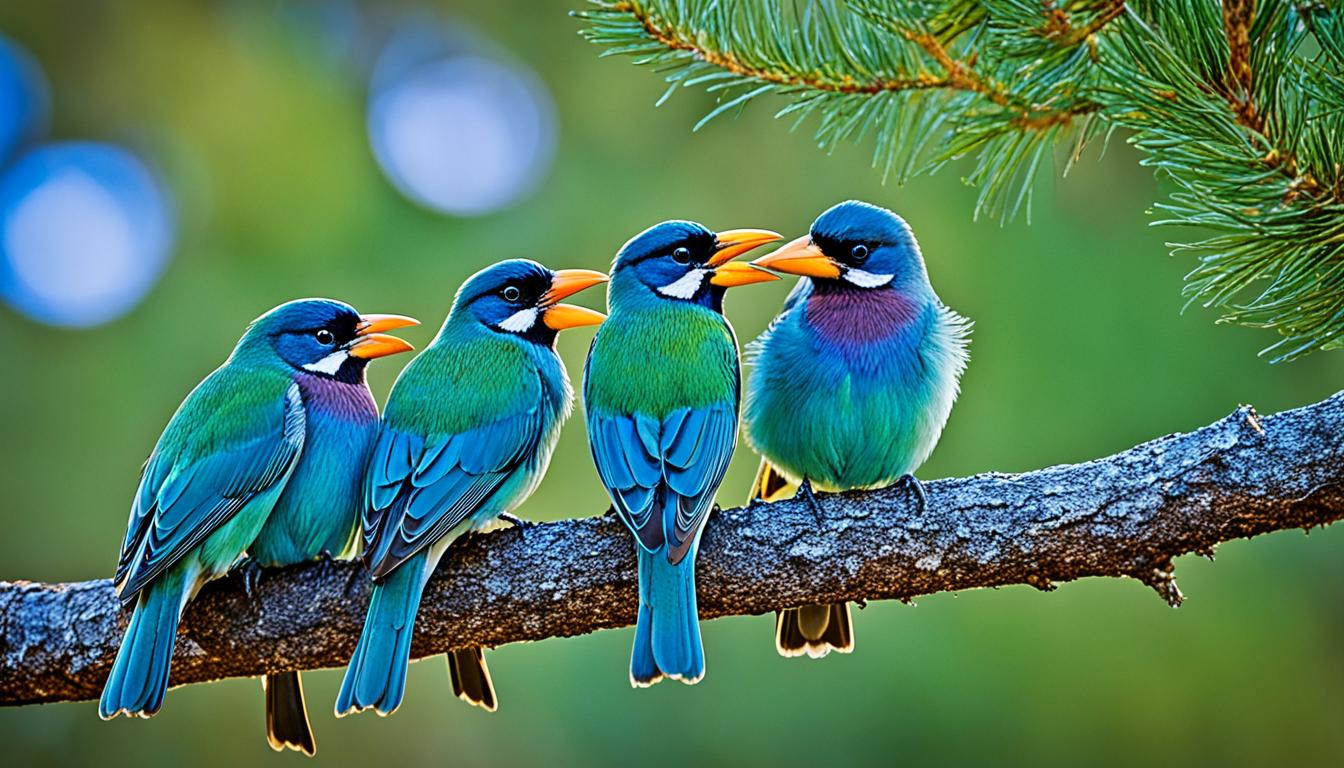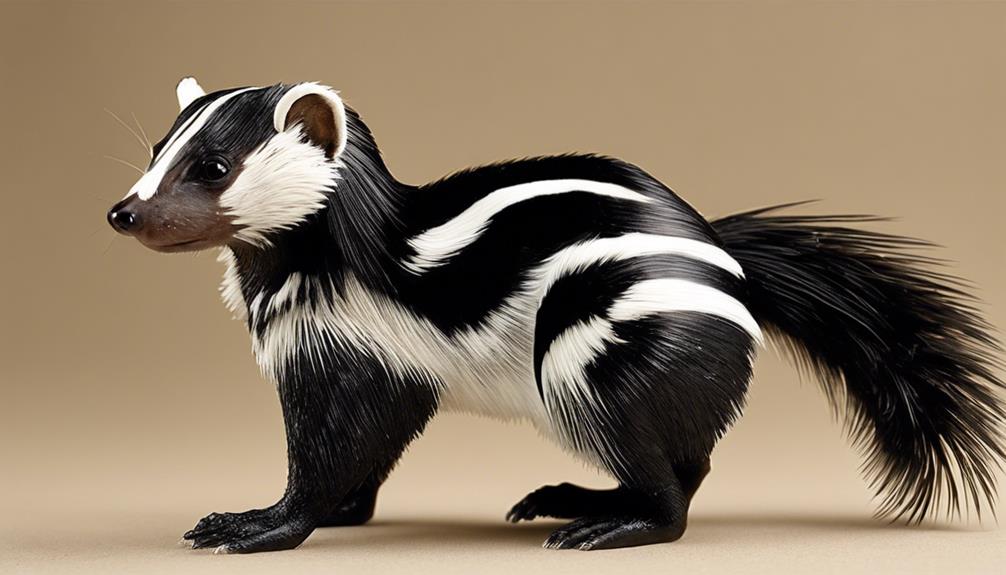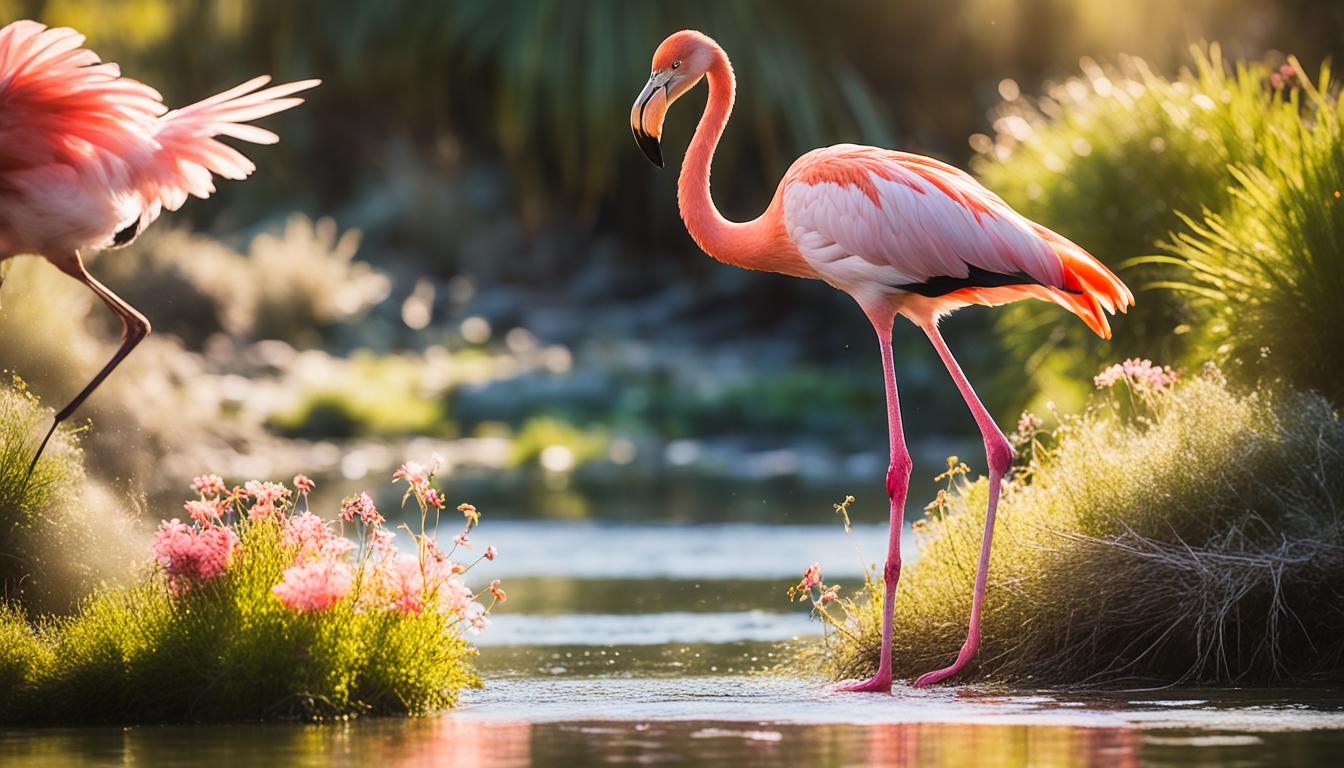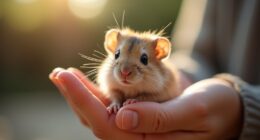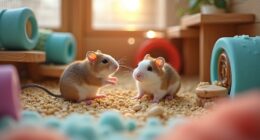Did you realize that California hosts more than 684 bird species? From the rugged coastlines to the majestic mountains, Northern California is a paradise for birdwatchers and nature lovers. Thanks to its varied habitats and pleasant climate, this area welcomes a variety of common birds all year round. Whether you’re an experienced birder or a novice, discovering the avian marvels of Northern California is certain to bring joy and inspiration.
Key Takeaways:
- Northern California is home to over 684 bird species.
- The region’s diverse habitats attract a wide range of common birds.
- Birdwatching in Northern California offers unique opportunities to observe and appreciate nature.
- Understanding the characteristics and habitats of common bird species can enhance your birdwatching experience.
- Conservation efforts play a crucial role in protecting bird populations and their habitats in Northern California.
Dark-eyed Junco
Dark-eyed Juncos are one of the most abundant songbirds in North America. These small, charming birds are known for their striking appearances and fascinating winter behavior.
During wintertime, Dark-eyed Juncos become snowbirds, migrating from their breeding grounds in northern forests and mountain ranges to more southerly regions, including Southern and Central California. They prefer coniferous coastal and mountain habitats year-round in these areas. The arrival of Dark-eyed Juncos in winter signals the changing of seasons and adds a touch of magic to the landscapes they inhabit.
To identify Dark-eyed Juncos, look for their distinctive features. These birds have conical-shaped bills and round heads, with their dark eyes giving them their name. Their plumage varies depending on the subspecies, but generally, they have gray or brown upperparts and white bellies. Some individuals have pink or buff-colored flanks. The contrasting colors make them easily recognizable against the backdrop of snow-covered landscapes.
Dark-eyed Juncos are social birds and often forage in small groups on the ground, scratching for seeds and insects. They primarily feed on seeds and are regular visitors to bird feeders during the winter months. Offering a variety of seeds and suet can attract these delightful visitors to your backyard.
“The Dark-eyed Junco, with its beautiful plumage and winter migration, is a true marvel of nature. Observing these snowbirds in their natural habitats is a joy for bird enthusiasts and nature lovers.” – Bird Watchers Magazine
As winter residents, Dark-eyed Juncos bring life and vitality to California’s landscapes during the colder months. Their presence serves as a reminder of the intricate connections between birds and the changing seasons. Whether hopping on the ground or perching in trees, Dark-eyed Juncos are a delightful sight for both experienced birdwatchers and casual observers alike.
Allen’s Hummingbird
Allen’s Hummingbirds bring a burst of vibrant colors and joyful energy as they herald the arrival of spring in the coastal regions of California. These tiny birds make a long journey, spending their winters in Mexico and arriving in the shrubby habitats of California as early as January. Drawn by the abundance of flowers that bloom after the winter rains, Allen’s Hummingbirds add a touch of beauty to the coastal landscapes.
During the spring migration, Allen’s Hummingbirds engage in elaborate courtship displays, captivating onlookers with their acrobatic flight patterns and flashing reddish-orange throats. These displays are an enchanting sight to behold as the males show off their vibrant colors to attract mates.
To give you a glimpse of the mesmerizing Allen’s Hummingbird in action, take a look at the stunning image below:
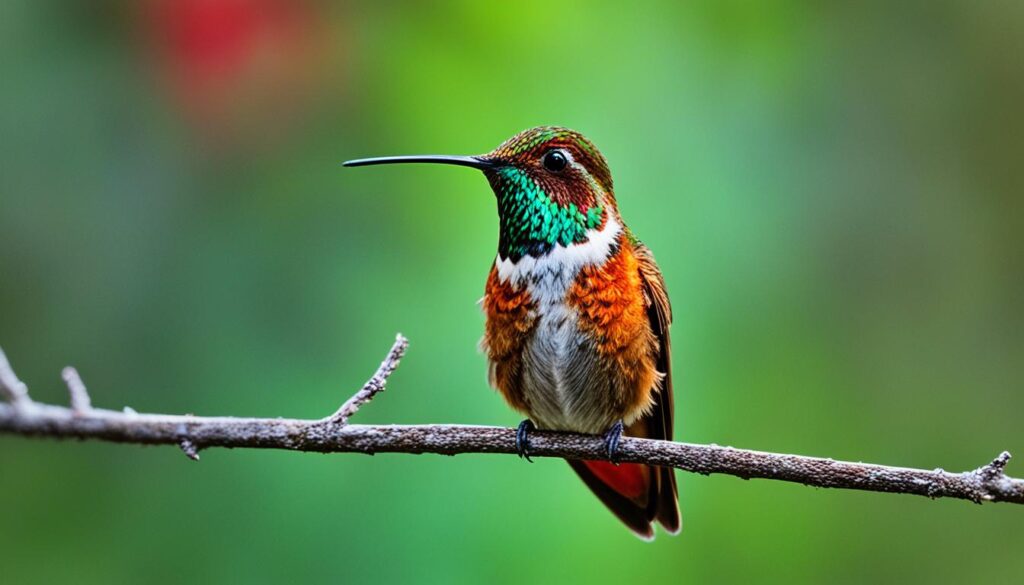
Explore the coastal regions of California during spring, and you may be lucky enough to witness these charming hummingbirds in their natural habitat. The Allen’s Hummingbird is truly a symbol of the changing seasons and the beauty of nature in the coastal regions of California.
California Towhee
The California Towhee, a sedentary bird exclusively found in California, is a common and easily recognizable species in the state. While there are a few exceptions in Oregon and the Baja Peninsula, these towhees are primarily residents of California’s diverse habitats. From wild chaparral hillsides to urban parks and gardens, they have adapted to various environments, thriving in both natural and human-altered landscapes. Their ability to adapt to urbanization has made them a familiar sight in towns and cities across the state.
California Towhees are known for their sedentary nature, rarely venturing far from their nesting areas. This behavior contributes to their abundant presence, as they establish territories and remain in the same vicinity throughout their lives. Their distinctive features, such as a rust-colored crown and a warm brown plumage, make them easily identifiable among other bird species.
These birds have a fascinating social structure, often forming monogamous pairs. They communicate through a variety of calls, including a melodic song that can be heard throughout the day. Additionally, California Towhees are ground foragers, hopping and scratching their way through leaf litter and underbrush in search of insects, seeds, and berries.
“The California Towhee is a delightful bird to observe, with its unique coloration and charming foraging behavior,” says renowned ornithologist Dr. James Peterson. “Their adaptability to urban environments is a testament to their resilience and ability to coexist with human settlements.”
To provide a comprehensive overview of California Towhees, here is a table highlighting their key characteristics:
| Species | California Towhee |
|---|---|
| Scientific Name | Melozone crissalis |
| Size | Approximately 8-9 inches in length |
| Plumage | Warm brown overall with a rust-colored crown |
| Habitat | Chaparral, scrublands, parks, gardens |
| Diet | Insects, seeds, berries |
| Behavior | Sedentary, ground forager, monogamous pairs |
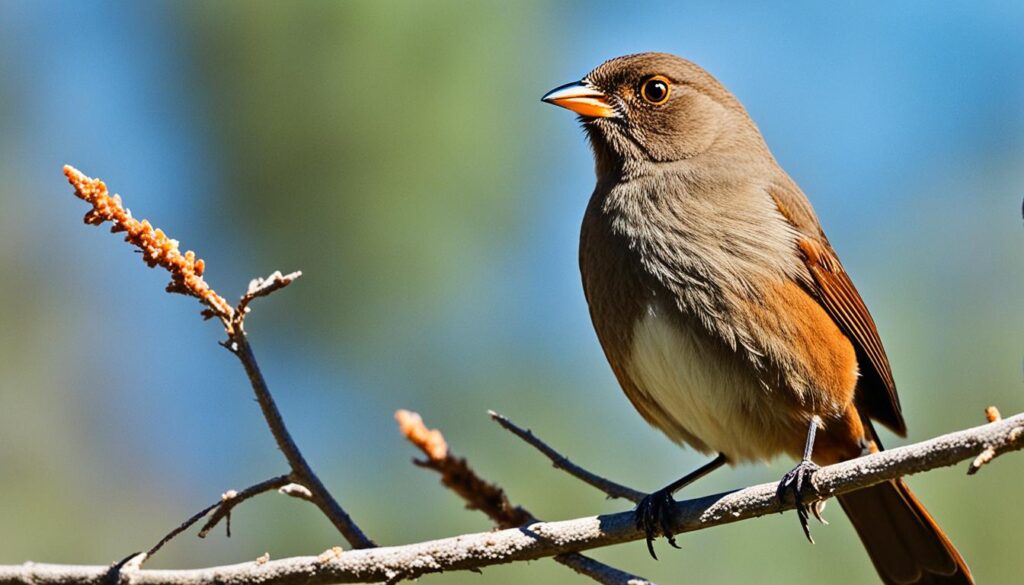
Observing California Towhees in their natural habitats or even in urban areas can provide bird enthusiasts with a unique glimpse into the avian diversity of California. Their ability to adapt to changing landscapes and their distinctive features make them a fascinating subject for birdwatchers and nature photographers.
Next, we will explore another captivating bird species of Northern California, the Oak Titmouse, known for its association with oak woodlands and cavity nesting behavior.
Oak Titmouse
The Oak Titmouse is a small, plain gray bird that is closely associated with the oak woodlands of California. With its small crest on the head and rapid, chattering calls, this species is easily recognizable. These birds primarily feed on insects and are commonly found in pairs or small family groups, actively foraging among the oak trees.
An interesting characteristic of the Oak Titmouse is its cavity nesting behavior. They often utilize natural cavities in trees or nest boxes for breeding and raising their young. Their preference for nesting in cavities makes them dependent on suitable habitat with mature oak trees. The forested areas of California’s oak woodlands provide the perfect environment for these cavity nesters to thrive.
The Oak Titmouse is a favorite among birdwatchers and backyard bird enthusiasts alike. They are attracted to feeders offering suet, seeds, or other high-energy foods. Providing a nesting box in your backyard can also attract these charming birds, allowing you to observe their nesting behaviors up close.
The Oak Titmouse’s association with oak woodlands and its habitat requirements make it an important indicator species for the health of these ecosystems. Protecting and preserving oak woodlands is crucial for the conservation of the Oak Titmouse and the many other species that rely on these unique habitats.
Key Features of the Oak Titmouse
- Closely associated with oak woodlands
- Small, plain gray bird with a small crest
- Feeds primarily on insects
- Forms pairs or small family groups
- Dependent on nesting in cavities
- Attracted to feeders offering suet or seeds
By understanding the habitat requirements and behaviors of the Oak Titmouse, birdwatchers and nature enthusiasts can further appreciate the importance of oak woodlands and contribute to their conservation efforts.
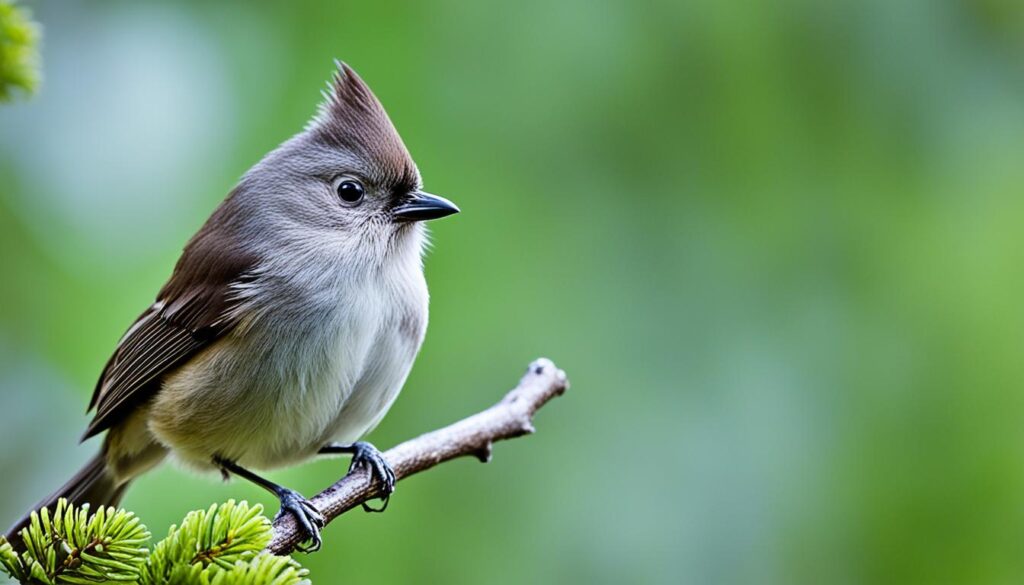
Cedar Waxwing
Cedar Waxwings are charming and sociable fruit-loving birds commonly found in California during the winter months. These elegant songbirds travel in large flocks, descending upon trees and shrubs laden with delicious berries, consuming them with gusto. With their vibrant plumage and distinctive red, wax-like droplets on their wing feathers, Cedar Waxwings add a burst of color to the winter landscape.
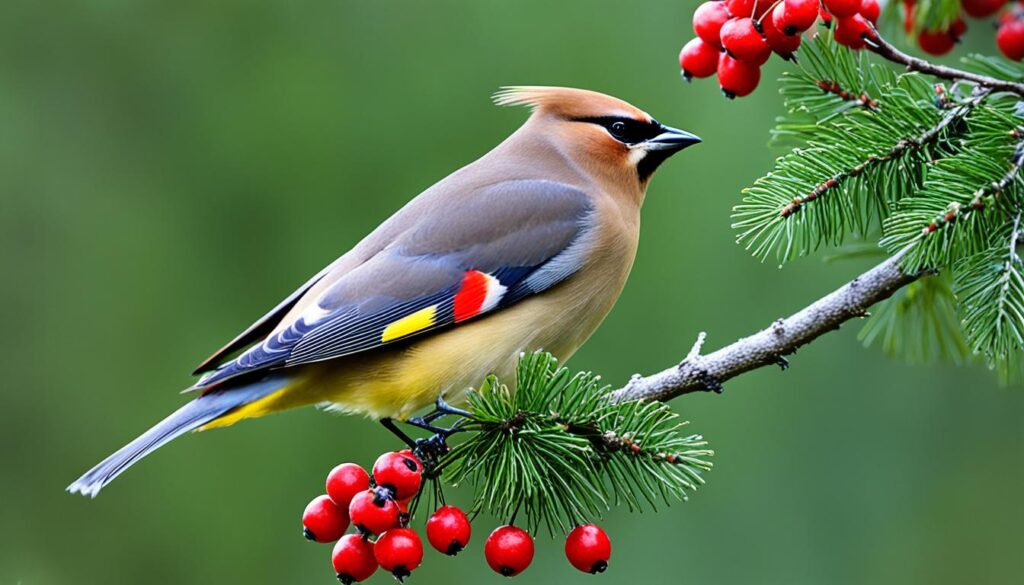
Nomadic Birds with a Passion for Fruit
One of the intriguing characteristics of Cedar Waxwings is their highly nomadic nature. These birds are constantly on the move in search of food, and their breeding and wintering territories can shift depending on the availability of fruit-bearing trees and shrubs. When their preferred food sources become depleted, they gracefully migrate to new areas in search of fresh feasting grounds.
A Feast for the Eyes and the Palate
When Cedar Waxwings gather in large flocks, their synchronized movements and collective feeding frenzy create a spectacle worth witnessing. Their efficient foraging technique allows them to swiftly remove the fruit from its branches, eating it whole or passing it to their flockmates in an elegant display of cooperative feeding. Observing Cedar Waxwings indulging in nature’s bounty is a visual feast for birdwatchers and nature enthusiasts alike.
“The sight of Cedar Waxwings devouring berries in unison is truly captivating. Their coordinated movements and melodious calls create a symphony of color and sound.”
Bird-Friendly Backyards
If you want to attract Cedar Waxwings to your backyard, the key is to provide them with a suitable habitat and a variety of fruit-producing native plants. These birds are known to visit gardens and backyard orchards, especially those with trees and shrubs that bear berries or fruits such as cherries, mulberries, and juniper berries. By creating a bird-friendly environment, you can enjoy the delightful presence of Cedar Waxwings and contribute to their conservation.
If you’re lucky enough to spot a Cedar Waxwing in your backyard, grab your camera and capture the moment. Their striking appearance and playful behavior make them a favorite subject for bird photographers.
California Scrub-Jay
California Scrub-Jays are lanky, blue jays that are common year-round residents in oak woodlands, dry shrublands, parks, and neighborhoods in coastal regions and foothills of California. They are known for their assertive, inquisitive, and vocal behavior, often visiting bird feeders. These jays are intelligent foragers, feeding on insects, fruits, seeds, nuts, and even small vertebrates. They are territorial birds and will defend their territories vigorously.
The Intelligent Foragers
The California Scrub-Jay is known for its highly adaptable feeding behavior. These birds have sharp beaks that allow them to access various food sources, making them versatile and intelligent foragers. They have been observed using tools, such as sticks and twigs, to extract insects from crevices or to pry open acorns and snails. This resourcefulness and ability to adapt their feeding strategies have contributed to their overall success as a species.
Territorial Behavior
California Scrub-Jays are fiercely territorial birds. They establish and defend their territories, which typically range from 2 to 12 acres in size. These territories provide them with ample food resources and nesting sites. The jays will vigorously defend their territories against other Scrub-Jays and even other bird species. They use a combination of vocal calls, aggressive displays, and physical confrontations to protect their territory from intruders.
“The California Scrub-Jay’s territorial behavior is fascinating to observe. These birds are not afraid to engage in confrontations and will vigorously defend their territory against any perceived threat. Their loud calls and aggressive displays serve as warnings to potential intruders.”

With their striking blue plumage and unique behaviors, California Scrub-Jays are captivating birds to observe in the wild. Whether they are foraging for food or vigorously defending their territories, these intelligent and territorial birds leave a lasting impression. The adaptability and resourcefulness of California Scrub-Jays make them an integral part of the diverse avian ecosystem in Northern California.
Cooper’s Hawk
The Cooper’s Hawk is a mid-sized bird-hunting hawk and the most common Accipiter species in California. With their long tails and rounded wings, these hawks are well-equipped to navigate through dense tree canopies in pursuit of their prey. Cooper’s Hawks primarily feed on medium-sized birds but also prey on small mammals. They are known for their agility and speed, making them formidable hunters in the sky.
One interesting aspect of Cooper’s Hawks is their size difference between males and females. Females are significantly larger than males, with the most pronounced size difference among all hawk species. This size disparity is believed to be advantageous for their hunting strategies, with females targeting larger prey and males focusing on smaller birds.
| Characteristics | Cooper’s Hawk | Sharp-shinned Hawk |
|---|---|---|
| Size | 17-20 inches (43-51 cm) | 9-13 inches (23-33 cm) |
| Wingspan | 31-37 inches (79-94 cm) | 20-27 inches (51-69 cm) |
| Weight | Female: 0.95-1.3 lbs (430-590 g) Male: 0.55-0.77 lbs (250-350 g) |
Female: 0.2-0.3 lbs (91-136 g) Male: 0.13-0.26 lbs (59-118 g) |
Cooper’s Hawks are often confused with their smaller cousin, the Sharp-shinned Hawk. They have similar plumage patterns and behaviors, making identification challenging. However, the size differences between the two species can be a helpful distinguishing factor. Additionally, Cooper’s Hawks tend to have a more rounded tail while Sharp-shinned Hawks have a squared-off tail.
If you’re lucky enough to spot a Cooper’s Hawk in the wild, take a moment to appreciate its hunting prowess and the remarkable size differences between males and females.
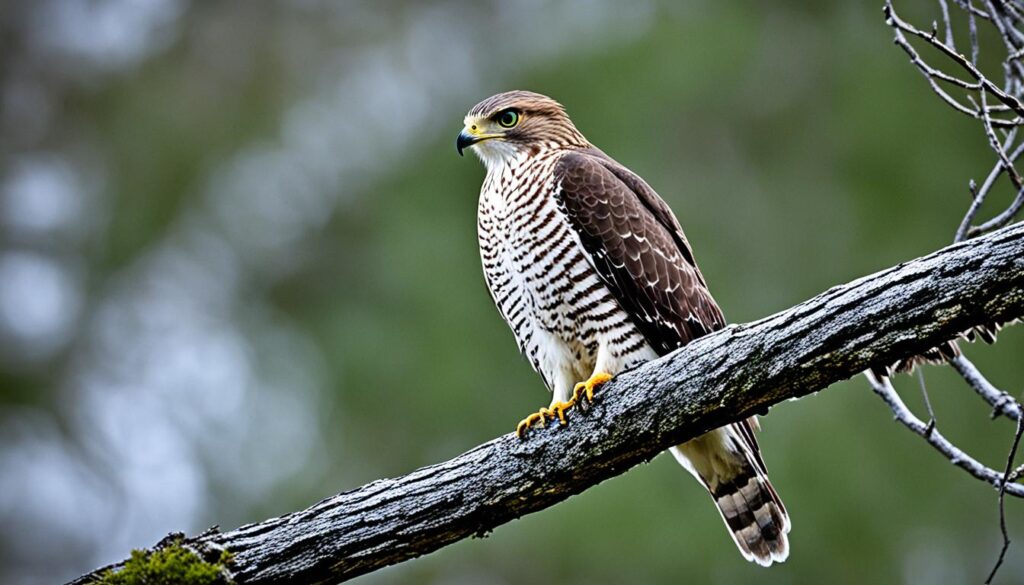
Yellow-rumped Warbler
The Yellow-rumped Warbler is a hardy and widespread species known for its distinctive yellow patch on its rump. This small songbird is a common wintering bird in California, where it can be found in small flocks among trees and shrubs. Unlike most warblers, the Yellow-rumped Warbler has a unique dietary preference that allows it to thrive in colder regions.
During the winter months, when food sources are scarce and temperatures drop, many warblers migrate to warmer climates. However, the Yellow-rumped Warbler has adapted to survive in colder regions by developing the ability to digest the waxy coating of berries. This unique dietary adaptation enables them to utilize an abundant food source during the winter, giving them a competitive advantage over other warblers.
The Yellow-rumped Warbler’s diet consists predominantly of berries, particularly those from trees such as junipers, wax myrtles, and bayberries. By consuming these high-energy fruits, the Yellow-rumped Warbler is able to sustain itself throughout the winter and remain in California’s colder regions when other warblers have migrated to more temperate areas.
“The Yellow-rumped Warbler’s ability to digest the waxy coating of berries gives it a significant advantage over other warblers during the winter months.”
In addition to its wintering habits, the Yellow-rumped Warbler also breeds in coniferous forests found in California’s mountain ranges. These forests provide suitable nesting habitats, where the warblers build cup-shaped nests using grasses, bark strips, and lichens. The female typically lays three to five eggs, which she incubates for about two weeks until they hatch.
Once the young have hatched, both parents are involved in feeding and caring for the nestlings. They primarily feed their offspring with high-protein food sources, such as insects and spiders, ensuring their healthy growth and development.
This adaptable and resourceful bird showcases the incredible diversity and survival strategies found among California’s avian species. Its ability to thrive in both wintering and breeding habitats, along with its unique dietary preference, makes the Yellow-rumped Warbler a remarkable and resilient species.

| Yellow-rumped Warbler | Description |
|---|---|
| Scientific Name | Setophaga coronata |
| Size | Approximately 5.5 – 6.3 inches (14 – 16 cm) in length |
| Weight | Average weight of 0.4 – 0.5 oz (10 – 14 g) |
| Appearance | Distinctive yellow patch on rump, gray back, white belly, streaked breast, and yellow patches on sides |
| Habitat | Coniferous and mixed forests, woodland edges, and shrubby habitats |
| Diet | Berries, insects, spiders |
| Conservation Status | Least Concern |
Chestnut-backed Chickadee
The Chestnut-backed Chickadee is a charming and sociable bird that calls the humid coniferous forests of coastal California its home. These non-migratory residents are often found in foraging flocks, joining forces with other chickadee species, nuthatches, and titmice, as they search for food and explore their woodland habitats. With their distinctive black caps and rich chestnut-colored backs, these small birds are easily recognizable.
One interesting aspect of the Chestnut-backed Chickadee is its eagerness to visit backyard feeders. These friendly birds are regular visitors to feeders that offer a variety of seeds or suet, providing bird enthusiasts with the opportunity to observe them up close and personal.
In recent years, the Chestnut-backed Chickadee has been expanding its geographic range. Once confined to the coastal areas of California, they have now colonized forest habitats in the central Sierra Nevada and even suburban areas in the eastern San Francisco Bay. This expansion demonstrates their adaptability and ability to thrive in different environments.
If you’re lucky enough to spot a Chestnut-backed Chickadee during your birdwatching adventures, take a moment to appreciate its cheerful presence and sociable nature. These delightful birds bring joy to both experienced birders and beginners alike.
“The Chestnut-backed Chickadee’s expanding range is a testament to its resilience and ability to adapt to changing environments.”
To better understand the characteristics and habits of the Chestnut-backed Chickadee, refer to the table below:
| Species | Scientific Name | Range | Size | Diet | Habitat |
|---|---|---|---|---|---|
| Chestnut-backed Chickadee | Poecile rufescens | Coastal California, central Sierra Nevada, eastern San Francisco Bay | 11-13 cm (4.3-5.1 in) | Insects, spiders, seeds, berries | Coniferous forests, suburban areas |
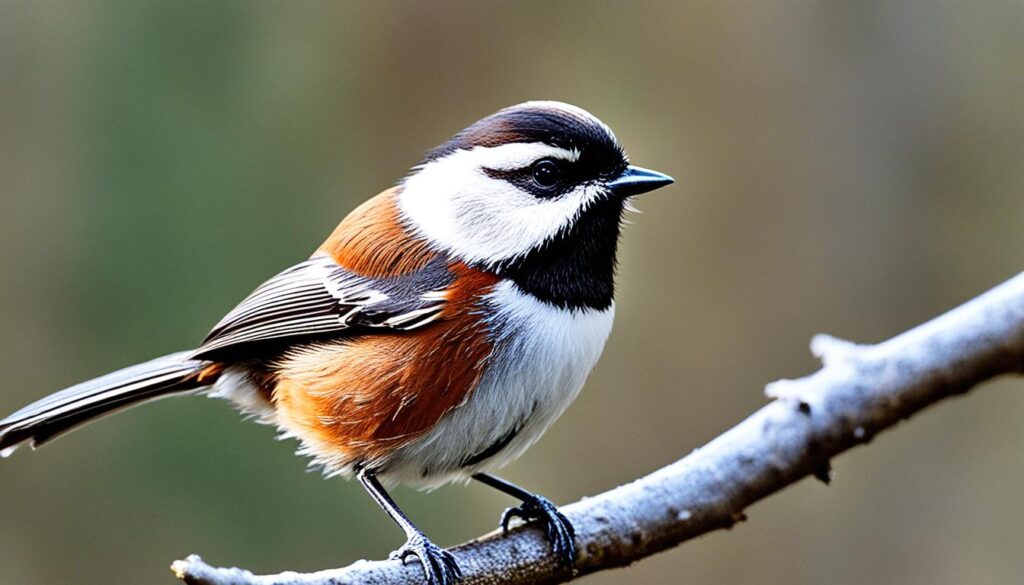
Observing the Chestnut-backed Chickadee
When observing the Chestnut-backed Chickadee, keep these tips in mind to enhance your birdwatching experience:
- Look for them in coniferous forests and suburban areas, paying attention to their distinct black caps and chestnut-colored backs.
- Listen for their cheerful, high-pitched calls and songs, which often consist of a series of clear, whistled notes.
- Set up a bird feeder with a variety of seeds and suet to attract these sociable birds to your backyard. Watch as they visit the feeder and interact with other bird species.
- Be patient and observant, as they may be part of a flock of other small birds, such as nuthatches and titmice.
By following these tips, you’ll increase your chances of encountering these delightful and expanding residents of California’s forests.
Overview of Common Birds in California
California is home to a diverse range of bird species, with over 684 documented species found within its borders. This abundance of avian life is thanks to the state’s wide variety of habitats, including forests, wetlands, farmlands, desert, scrublands, and coastal areas. The habitat diversity provides favorable conditions for a wide range of bird species to thrive.
While some species, such as the Tricolored Blackbird and California Gnatcatcher, are endangered due to habitat destruction, most birds in California are still common and can be easily observed. Whether you’re an experienced birdwatcher or just starting out, California offers ample opportunities to appreciate and learn about its feathered residents.
In addition to the iconic bird species that call California home, the state also attracts a multitude of migratory birds throughout the year. These birds use California as a vital stopover point on their long journeys, further enriching the birdwatching experience for enthusiasts.
Common Bird Species in California
Here are just a few examples of the common bird species you might encounter in California’s diverse habitats:
- American Robin: These thrushes are known for their vibrant orange breasts and cheerful songs. They can be found in a variety of habitats including gardens, parks, and woodlands.
- Mourning Dove: With their distinctive cooing calls, Mourning Doves are a familiar sight in urban areas, agricultural fields, and open habitats throughout the state.
- Anna’s Hummingbird: This charismatic hummingbird is a year-round resident in California, known for its iridescent plumage and incredible aerial acrobatics.
- California Quail: The state bird of California, these plump, ground-dwelling birds can often be seen in groups running along roadsides or foraging for seeds in grassy areas.
Bird Habitat Diversity in California
| Habitat Type | Main Bird Species |
|---|---|
| Coastal Areas | Brown Pelican, Heermann’s Gull, Western Snowy Plover |
| Mountains | Steller’s Jay, Mountain Bluebird, Townsend’s Solitaire |
| Wetlands | American Coot, Black-necked Stilt, White-faced Ibis |
| Deserts | Roadrunner, Greater Roadrunner, Cactus Wren |
| Forests | Northern Spotted Owl, Varied Thrush, Olive-sided Flycatcher |
| Farmlands | Western Meadowlark, Barn Owl, Swainson’s Hawk |
| Scrublands | California Scrub-Jay, California Thrasher, Sage Sparrow |
Regardless of where you find yourself in California, there is always a fascinating array of bird species waiting to be discovered. So grab your binoculars, explore the state’s habitat diversity, and get ready to witness the wonder of California’s common birds.
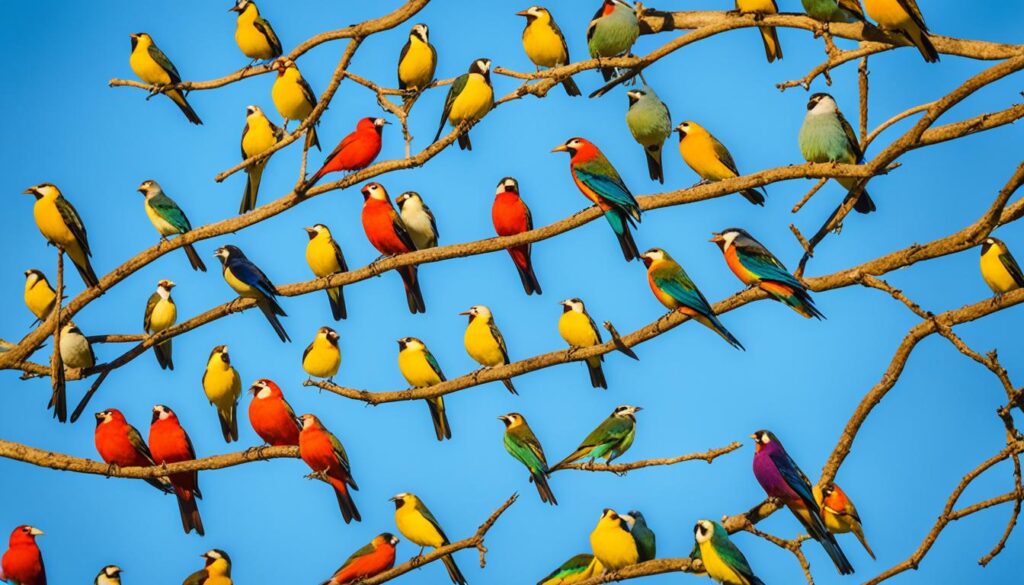
Most Common Birds in California
To help birdwatchers identify the most common birds in California, we have compiled a list based on eBird data. This list includes species that are frequently observed and provides information on their appearance, behavior, and habitats. From House Finches and American Crows to Anna’s Hummingbirds and White-crowned Sparrows, these birds can be found in various habitats across the state.
| Common Name | Scientific Name | Appearance | Behavior | Habitat |
|---|---|---|---|---|
| House Finch | Haemorhous mexicanus | Small size, brown or yellow plumage, red or orange crown | Social, often seen in flocks, frequent visitor to feeders | Urban areas, woodlands, deserts |
| American Crow | Corvus brachyrhynchos | Large size, all black plumage | Intelligent, vocal, opportunistic feeder | Wide variety of habitats, including urban areas |
| Anna’s Hummingbird | Calypte anna | Small size, iridescent green back, rose-pink throat | Aggressive, territorial, prominent aerial displays | Coastal areas, gardens, parks |
| White-crowned Sparrow | Zonotrichia leucophrys | Medium size, gray or brown plumage, bold black and white crown | Ground forager, migratory, distinctive song | Grasslands, shrublands, gardens |
These are just a few examples of the most common birds you may encounter while birdwatching in California. By familiarizing yourself with their characteristics and preferred habitats, you’ll be better equipped to identify and appreciate the diverse avian population in the state.
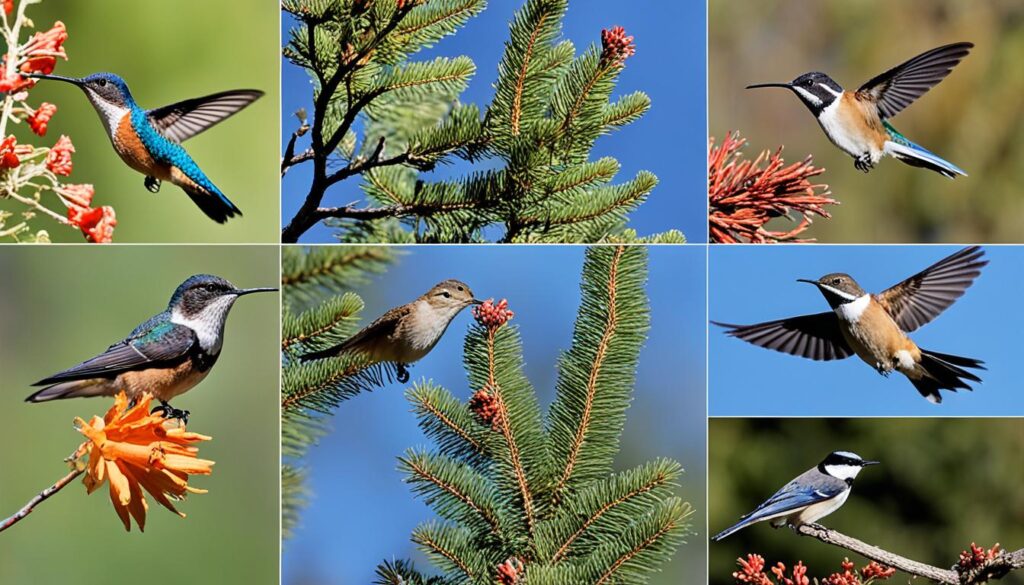
Birds of Northern California
Northern California offers a unique opportunity for bird photography enthusiasts. The region is home to a diverse range of bird species, including the American White Pelican, California Clapper Rail, and Western Bluebird. With its stunning landscapes and abundance of birdlife, Northern California provides ample opportunities to capture breathtaking photos of these feathered creatures in their natural habitats.
Whether you’re a seasoned bird photographer or just starting out, Northern California’s varied ecosystems offer endless possibilities for capturing stunning images. From the rugged coastline to the majestic mountains, each location presents its own unique bird species and photographic challenges. Here are some notable birds that you can find in Northern California:
| Bird Species | Key Features | Habitat |
|---|---|---|
| American White Pelican | Large size, white plumage, distinctive bill | Coastal areas, lakes, and wetlands |
| California Clapper Rail | Medium-sized, long-billed bird, mottled brown feathers | Marshes, estuaries, and tidal flats |
| Western Bluebird | Vibrant blue plumage, reddish-brown breast, white belly | Woodlands, open country, and suburban areas |
Photography Tips:
- Research bird behavior and habitats to increase your chances of sighting and photographing specific species.
- Invest in a quality telephoto lens to capture birds in their natural habitats without disturbing them.
- Experiment with different angles and perspectives to add variety to your bird photography portfolio.
- Utilize natural lighting and consider the time of day for optimal photo opportunities.
- Patience is key – be prepared to spend time observing and waiting for the perfect shot.
Exploring the birds of Northern California through photography allows you to appreciate the incredible beauty and diversity of nature. So grab your camera, head out to the stunning landscapes, and capture the essence of these magnificent birds in their natural habitats.
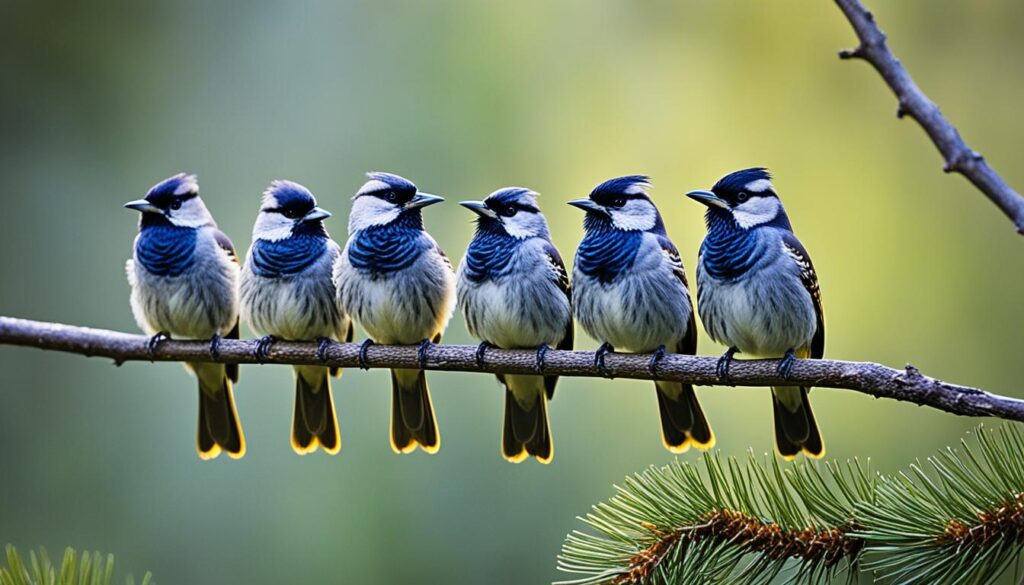
Birds in Flight in Northern California
Capturing photos of birds in flight can be both challenging and rewarding. Northern California’s diverse landscapes provide an ideal setting for capturing dynamic images of birds in action. Whether it’s soaring hawks, diving terns, agile swallows, or graceful herons, the region offers a wealth of opportunities to witness the beauty of birds in flight.
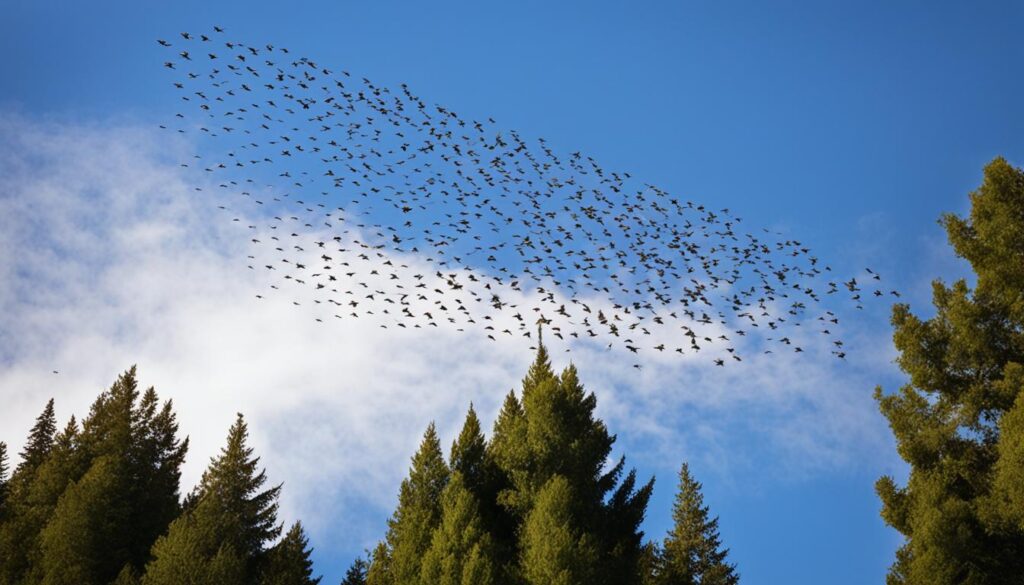
Photography Tips for Capturing Birds in Flight
Photographing birds in flight requires skill and practice. Here are some helpful tips to improve your chances of capturing stunning images:
- Use a fast shutter speed: Birds move quickly, so to freeze their motion, ensure your camera’s shutter speed is set to a high value, such as 1/1000 or faster.
- Focus on the eyes: The eyes are the focal point of any bird photo. Use autofocus or manual focus to ensure sharpness on the bird’s eyes.
- Anticipate the action: Birds in flight exhibit predictable patterns, such as banking or diving. Anticipate these movements to capture the perfect shot.
- Shoot in burst mode: Birds’ flight patterns can be unpredictable, so shooting in burst mode allows you to capture a series of photos in quick succession to increase your chances of getting the perfect shot.
- Experiment with composition: Play with different angles, perspectives, and framing to create visually interesting and dynamic compositions.
- Be patient: Patience is key when photographing birds in flight. Spend time observing their behavior and flight patterns to anticipate moments that make for captivating photographs.
Birds in Flight Photography Equipment Recommendations
| Equipment | Suggested Model |
|---|---|
| Camera Body | Nikon D500 |
| Telephoto Lens | Canon EF 100-400mm f/4.5-5.6L IS II USM |
| Tripod | Manfrotto 055 Carbon Fiber Tripod |
| Memory Cards | SanDisk Extreme PRO SDXC UHS-I Memory Card |
| Battery | Canon LP-E6N Lithium-Ion Battery |
“Photography is a way of feeling, of touching, of loving. What you have caught on film is captured forever… It remembers little things, long after you have forgotten everything.” – Aaron Siskind
With these photography tips and the right equipment, you’ll be well on your way to capturing stunning images of birds in flight in Northern California. Remember to respect the birds’ natural habitats and maintain a safe distance while enjoying the beauty of these graceful creatures in action.
Conservation of Birds in Northern California
Protecting bird populations and their habitats is crucial for the long-term survival of bird species in Northern California. Various organizations and conservation efforts are working tirelessly to preserve and restore critical habitats, such as wetlands and forests, that are essential for nesting, feeding, and migration. Additionally, promoting bird-friendly practices is vital in ensuring the well-being of these feathered creatures.
Promoting Bird-Friendly Practices
To contribute to the conservation of bird species in Northern California, individuals and communities can adopt several bird-friendly practices:
- Reducing Pesticide Use: Avoiding the use of harmful pesticides minimizes the risk of contaminating bird habitats and food sources.
- Providing Nesting Boxes: Installing nesting boxes in suitable locations can provide additional nesting opportunities for cavity-nesting birds.
- Planting Native Vegetation: Choosing native plants in gardens and landscaping projects helps attract birds by providing them with familiar food sources and shelter.
Conservation Efforts and Organizations
Several organizations in Northern California play a crucial role in bird conservation:
- Audubon California: Audubon California focuses on protecting priority bird species and their habitats through science-based advocacy and community engagement.
- California Audubon Society: The California Audubon Society works to conserve and restore vital bird habitats, promote wildlife-friendly policies, and engage communities in bird education and conservation.
- San Francisco Bay Bird Observatory: This organization conducts bird research, promotes bird conservation, and works on habitat restoration projects.
“Conserving bird habitats is not only essential for bird populations but also for the overall health of our ecosystems. Every effort, no matter how small, contributes to the protection of these beautiful creatures and the natural world we share.” – John Davis, Conservation Biologist
Habitat Protection and Restoration
Habitat protection and restoration efforts are crucial in ensuring the survival of bird species in Northern California. Wetlands, forests, and other critical habitats serve as essential breeding grounds, foraging areas, and stopover sites during migration. By preserving and restoring these habitats, we can support the diverse bird populations that rely on them.

| Habitat | Key Bird Species |
|---|---|
| Wetlands | American White Pelican, California Clapper Rail |
| Forests | Acorn Woodpecker, Northern Pygmy-Owl |
| Coastal Areas | Western Bluebird, Black Oystercatcher |
Preserving and restoring these habitats involves land acquisition, implementing conservation strategies, and maintaining sustainable management practices. It is crucial for individuals, organizations, and policymakers to work hand in hand to ensure the long-term survival of bird species in Northern California and protect the natural beauty this region offers.
Conclusion
Northern California is a birdwatcher’s paradise, offering a rich diversity of common bird species in its various habitats. From the Dark-eyed Junco and Allen’s Hummingbird to the California Scrub-Jay and Yellow-rumped Warbler, these avian residents bring life and vibrancy to the region.
By exploring the diverse landscapes of Northern California, bird enthusiasts can immerse themselves in the beauty and wonder of the avian world. Each species has its unique characteristics and behaviors, from the winter residents like the Dark-eyed Junco to the nomadic Cedar Waxwing. Observing these birds in their natural habitats provides an opportunity to witness their mesmerizing courtship displays, acrobatic flights, and distinctive calls.
The conservation of bird species in Northern California is of utmost importance to preserve their populations and habitats. By supporting organizations and initiatives focused on habitat protection, birdwatchers can contribute to the long-term survival of these common birds. Additionally, adopting bird-friendly practices such as reducing pesticide use and providing nesting boxes can create a conducive environment for these feathered inhabitants.
Embark on a rewarding journey to explore the common birds of Northern California and discover the endless marvels of the avian world. With their captivating plumage, enchanting songs, and remarkable behaviors, these birds enrich the natural landscapes and create a harmonious connection between humans and wildlife in this picturesque region.
